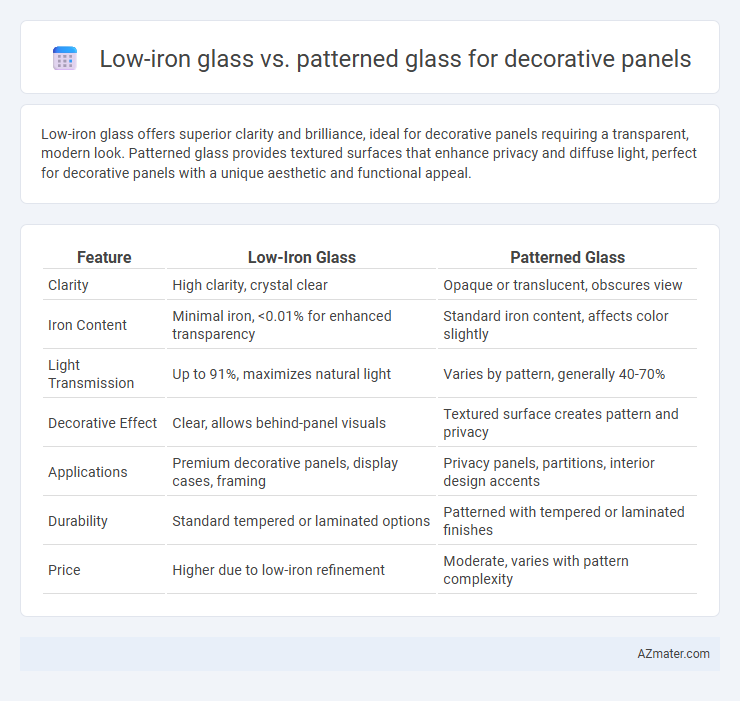Low-iron glass offers superior clarity and brilliance, ideal for decorative panels requiring a transparent, modern look. Patterned glass provides textured surfaces that enhance privacy and diffuse light, perfect for decorative panels with a unique aesthetic and functional appeal.
Table of Comparison
| Feature | Low-Iron Glass | Patterned Glass |
|---|---|---|
| Clarity | High clarity, crystal clear | Opaque or translucent, obscures view |
| Iron Content | Minimal iron, <0.01% for enhanced transparency | Standard iron content, affects color slightly |
| Light Transmission | Up to 91%, maximizes natural light | Varies by pattern, generally 40-70% |
| Decorative Effect | Clear, allows behind-panel visuals | Textured surface creates pattern and privacy |
| Applications | Premium decorative panels, display cases, framing | Privacy panels, partitions, interior design accents |
| Durability | Standard tempered or laminated options | Patterned with tempered or laminated finishes |
| Price | Higher due to low-iron refinement | Moderate, varies with pattern complexity |
Introduction to Decorative Glass Panels
Low-iron glass offers high clarity and a nearly colorless appearance, making it ideal for decorative panels that require a sleek, modern aesthetic and maximum light transmission. Patterned glass features textured surfaces that enhance privacy and add visual interest through intricate designs, perfect for decorative applications where subtle opacity and decorative effects are desired. Both materials serve distinct purposes in decorative glass panels, catering to different design needs and functional requirements.
What is Low-Iron Glass?
Low-iron glass is a high-transparency glass with reduced iron content, resulting in minimal green tint and enhanced clarity, making it ideal for decorative panels requiring true color representation. It offers superior light transmission compared to standard patterned glass, which typically features textured or embossed surfaces that diffuse light for privacy and aesthetic effects. Low-iron glass provides a sleek, modern look with exceptional visual clarity, whereas patterned glass emphasizes decorative texture and obscurity.
What is Patterned Glass?
Patterned glass is textured glass with embossed designs that create visual interest and diffuse light, commonly used in decorative panels for privacy and aesthetics. Unlike low-iron glass, which enhances clarity and reduces green tint, patterned glass obscures vision while still allowing natural light to filter through. Its unique textures range from geometric shapes to organic patterns, making it a versatile choice for enhancing interior designs.
Visual Clarity: Low-Iron vs Patterned Glass
Low-iron glass offers superior visual clarity due to its reduced green tint, making it ideal for decorative panels that require a clear, true-to-color appearance. Patterned glass features textured surfaces that diffuse light and obscure visibility, enhancing privacy but reducing transparency. Choosing low-iron glass maximizes brightness and detail visibility, while patterned glass emphasizes aesthetic texture and visual distortion for decorative effects.
Light Transmission and Aesthetic Impact
Low-iron glass offers superior light transmission due to its reduced iron content, allowing for clearer and brighter decorative panels that enhance natural lighting and color accuracy. Patterned glass, with its textured surfaces, diffuses light to create privacy and add visual interest while slightly diminishing overall light transmission compared to low-iron glass. Selecting between low-iron and patterned glass depends on balancing the need for maximum light clarity with decorative and privacy aesthetics in interior design applications.
Durability and Maintenance Comparison
Low-iron glass offers superior durability with enhanced resistance to scratches and chemical damage, making it ideal for long-lasting decorative panels. Patterned glass, while aesthetically versatile, generally requires more frequent maintenance due to its textured surface that can trap dust and grime. Both materials demand routine cleaning, but low-iron glass often results in lower upkeep costs over time because of its smoother, non-porous finish.
Applications in Modern Interior Design
Low-iron glass enhances decorative panels with superior clarity and true color rendition, making it ideal for minimalist and high-end modern interior designs where transparency and light transmission are crucial. Patterned glass introduces texture and privacy, commonly used in partitions and decorative elements within contemporary office spaces, bathrooms, and feature walls to create visual interest while maintaining light diffusion. Combining both materials allows designers to balance aesthetic appeal and functional requirements, optimizing spatial ambiance in residential and commercial environments.
Cost Considerations
Low-iron glass typically incurs higher production costs due to its enhanced clarity and reduced green tint, making it a premium option for decorative panels. Patterned glass, often manufactured with textured molds or rollers, usually offers more cost-effective pricing but may compromise on visual clarity and light transmission. When budgeting for decorative panels, choosing low-iron glass involves investing in superior aesthetics, while patterned glass allows for creative textures at a lower cost.
Environmental Impact and Sustainability
Low-iron glass offers higher clarity and energy efficiency due to its reduced iron content, which enhances natural light transmission and contributes to lower lighting energy consumption in decorative panels. Patterned glass, while aesthetically versatile, often requires more manufacturing processes that can result in higher carbon emissions and resource use compared to the simpler refining of low-iron glass. Both materials can be recycled, but the lower processing intensity and improved energy performance of low-iron glass generally support greater environmental sustainability in panel applications.
Choosing the Right Glass for Decorative Panels
Low-iron glass offers exceptional clarity and neutrality, making it ideal for decorative panels where true color representation and maximum light transmission are crucial. Patterned glass provides texture and privacy, adding visual interest and diffusing light while obscuring views, suitable for decorative elements requiring subtle design enhancements. Selecting between low-iron and patterned glass depends on the desired aesthetic effect, transparency level, and functional needs of the decorative panel.

Infographic: Low-iron glass vs Patterned glass for Decorative panel
 azmater.com
azmater.com